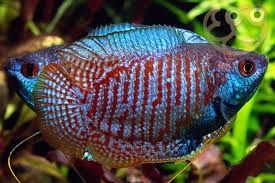Neon Dwarf Gourami (Trichogaster lalius)
Neon Dwarf Gourami (Trichogaster lalius)
The Neon Dwarf Gourami (Trichogaster lalius), often simply referred to as the Dwarf Gourami, is a small, vibrant fish that makes a beautiful addition to freshwater aquariums. Known for its striking neon-blue coloration (especially in males) and peaceful nature, this species is perfect for community tanks.
1. Tank Size
-
Neon Dwarf Gouramis are small fish, typically reaching around 2 inches (5 cm) in length.
-
A 10-gallon tank (38 liters) is suitable for a single Neon Dwarf Gourami, but it’s better to have a 20-gallon tank (76 liters) if you're keeping multiple fish or planning to add other species.
-
They are relatively peaceful and can live with other community fish as long as the tank isn’t overcrowded.
2. Water Conditions
-
Temperature: These fish prefer warm water, with a temperature range of 75°F to 82°F (24°C to 28°C).
-
pH: A slightly acidic to neutral pH range of 6.0 to 7.5 is ideal.
-
Hardness: Soft to moderately hard water is best, with a hardness range of 4-18 dGH.
-
Water Quality: Regular water changes (about 25% per week) are crucial to maintain optimal water quality. These fish are sensitive to poor water conditions, so keep an eye on ammonia and nitrite levels, ensuring they stay at 0 ppm.
3. Diet
-
Neon Dwarf Gouramis are omnivores and will accept a variety of foods:
-
High-quality flakes or pellets designed for small fish.
-
Frozen or live foods like brine shrimp, daphnia, bloodworms, and microworms.
-
Vegetable matter, such as blanched spinach, spirulina, or algae-based foods.
-
-
Feed them small amounts 2-3 times a day, making sure not to overfeed.
4. Tank Setup
-
Substrate: A fine gravel or sand substrate works well and is easy to clean.
-
Aquascaping: They prefer tanks with planted environments and plenty of hiding spots. Live plants like Java Fern, Anubias, Hornwort, or Amazon Sword are great choices. Floating plants like Duckweed can also offer some shade.
-
Water Movement: Neon Dwarf Gouramis don’t like strong water flow, so a gentle filter is best. Keep the water movement slow to moderate to allow the fish to swim comfortably.
-
Lighting: Moderate lighting is ideal for these fish. They enjoy the natural cover provided by plants and floating vegetation.
5. Tankmates
-
Neon Dwarf Gouramis are peaceful and do well in community tanks with other small, non-aggressive fish.
-
Good tankmates include:
-
Small tetras (e.g., Neon Tetras, Ember Tetras), Rasboras, and small catfish (e.g., Corydoras).
-
Shrimp (e.g., Cherry Shrimp) and snails can also be added to the tank without issue.
-
-
Be cautious when keeping more than one male Dwarf Gourami in the same tank, as they can become territorial and may fight. It's often better to have one male and multiple females if you're keeping more than one.
-
Avoid keeping them with aggressive fish (e.g., large cichlids) that might bully them.
6. Breeding
-
Breeding Neon Dwarf Gouramis can be done with the right setup, as they are bubble-nest builders.
-
Set up a breeding tank with soft, slightly acidic water, a gentle filter, and floating plants to help the male build a nest.
-
The male will build a bubble nest at the water's surface and court the female by swimming in an elegant display.
-
After spawning, the female lays her eggs in the nest. Once the eggs are fertilized, the male will guard them.
-
After the eggs hatch (usually within 24-48 hours), the fry should be fed infusoria or liquid fry food until they are large enough to eat crushed flakes or baby brine shrimp.
7. Health
-
These fish are generally hardy, but they are sensitive to poor water quality, so maintaining clean, stable water is crucial.
-
Common health issues include:
-
Fin rot and skin infections: Often caused by poor water conditions or injury. Keep the tank clean and provide appropriate treatment if necessary.
-
Ich: A common parasite, often triggered by stress or sudden temperature changes. Maintaining a stable environment can help prevent outbreaks.
-
Gourami disease (Lymphocystis): This viral infection can cause swelling and growths on the skin, though it’s generally not fatal. Quarantining affected fish is important.
-
Interesting Fact:
Neon Dwarf Gouramis are known for their beautiful color patterns, with males often displaying a vibrant neon-blue or red coloration along their sides. This stunning display is more pronounced when they are in good health, well-fed, and in a proper breeding environment. Interestingly, their colors are not only for beauty but also to attract mates during the breeding season, with males intensifying their coloration to woo females. In the wild, they are often found in slow-moving rivers and ponds with dense vegetation, where their small size and colorful markings help them blend into their environment.

